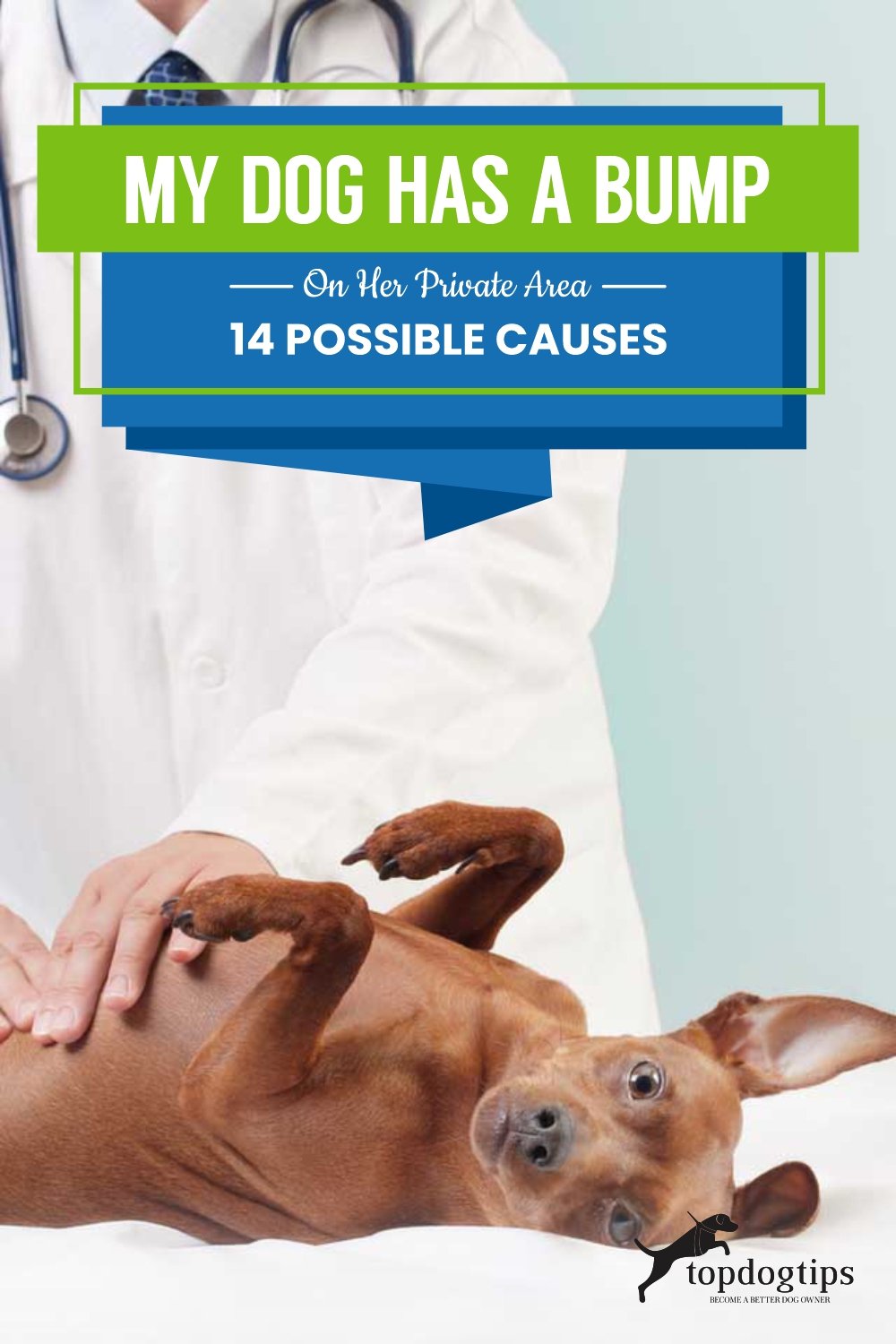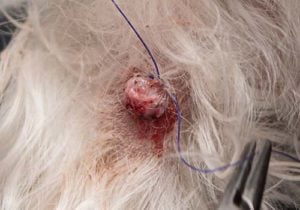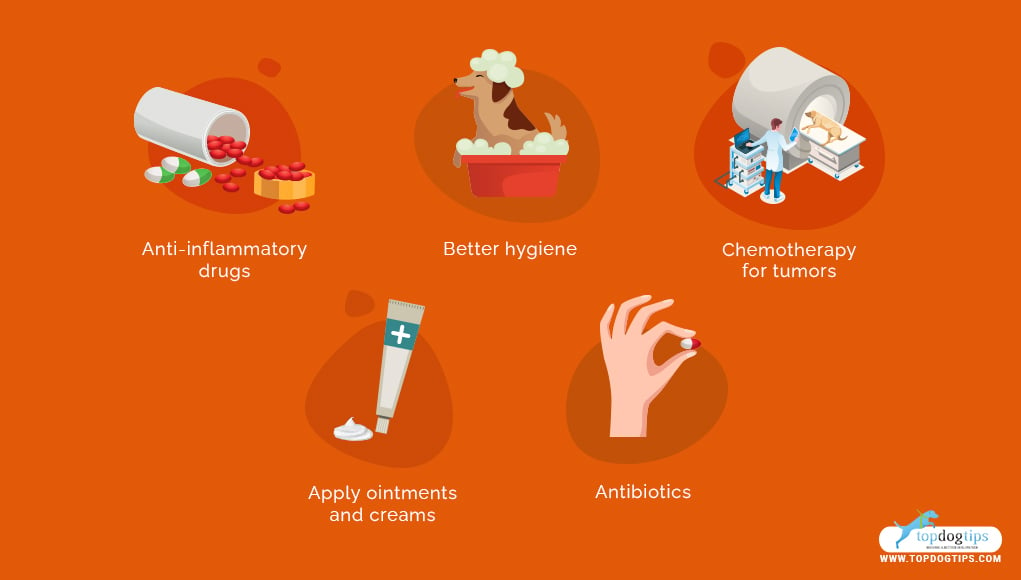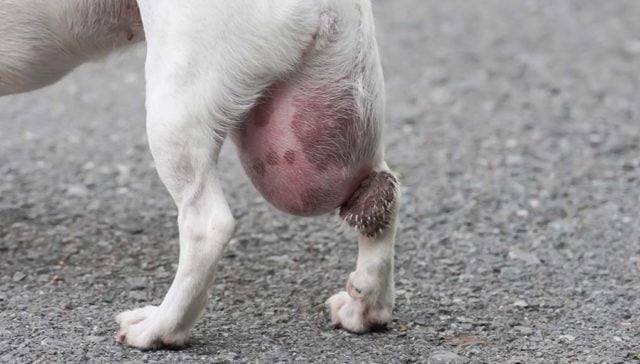
Table of Contents
Any foreign bumps and lumps on our dogs are pretty worrisome, especially if you find them in areas that are more sensitive than others.
So if you notice that your dog has a bump on her private area, the best course of action is to consult a professional veterinarian.
They will be able to make the proper diagnosis and treatment for the strange bump.
But don't worry; you already did a good job spotting that bump!
According to Dr. Dana Connell of the University of Illinois Veterinary Teaching Hospital, the masses that develop on the underside of our pets are often less likely to be discovered by owners for obvious reasons.
These lumps on dogs are often found in areas where they are always petted.
“Lumps can be found anywhere on a pet’s body,” Dr. Connell says, “though they are typically found on the top of the head or chin, in areas where the animal is frequently touched.”
Usually, it'll be nothing to worry about.
But there are instances where this could be something more dangerous; thus, you must know how to recognize its type of growth so you'd be able to report it as accurately as possible to your vet.
In this article, I have listed 14 possible causes of bumps on a dog's vagina.
I've also included pictures of each condition that you can compare to the lump you found on your dog.
RELATED: 6 Common and Serious Dog Skin Conditions (And What to Do About Them)
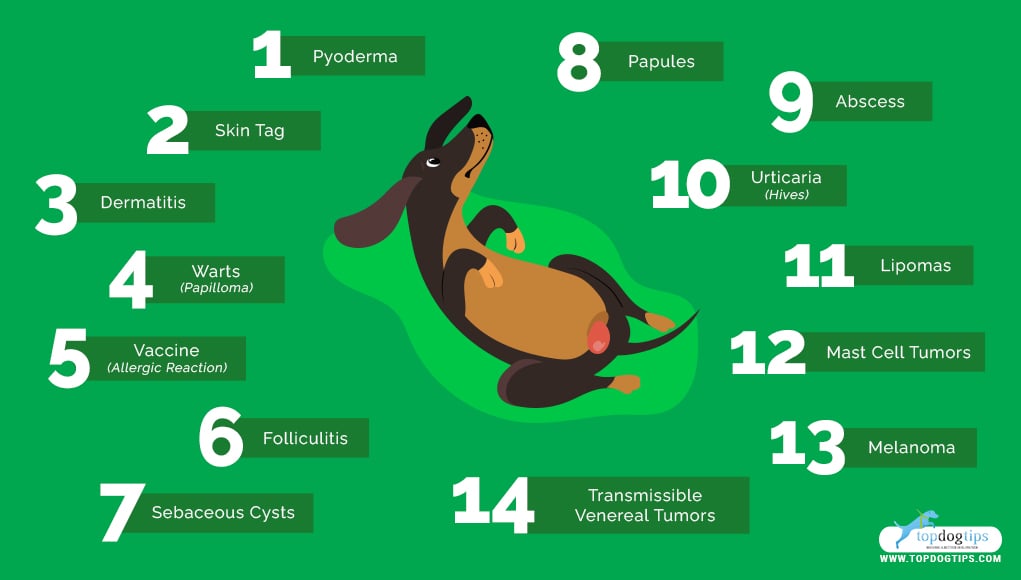
Dog Has a Bump on Her Private Area? One of these might be the culprit!
Luckily, benign bumps in dogs are more frequent than malignant ones, and they are not complicated to treat in most cases.
But if a cancerous growth occurs, the outcome of your dog's condition will primarily depend on the speed of your response.
You can get a better idea by looking at the dog bump pictures below, but bring the dog to the vet anyway.
Early veterinary diagnosis and timely treatment will significantly increase the chances of the outcome being favorable.
1. Pyoderma 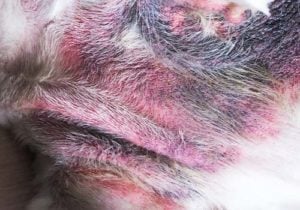
Pyoderma is a purulent skin disease in dogs caused by bacteria that multiply in the vulva and penis area.
Another reason for this is skin friction during movement, particularly in overweight dogs.
When the animal rubs two surfaces of the skin against each other continually, it will become moist and, consequently, inflamed.
2. Skin Tag 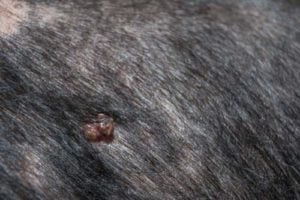
Skin tags are fairly common to see on a dog's body, including their private areas.
These fibrous growths usually occur on the skin of older dogs of any breed or gender, but large-breed dogs are generally more prone to this condition.
Fortunately, these bumps are harmless and don't require any treatment.
3. Dermatitis 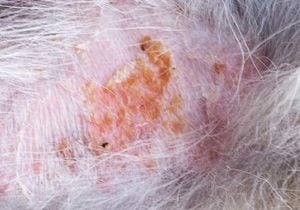
There are a few types of dermatitis in dogs, but all of them include some skin inflammation.
In the case of bumps on a dog's vagina and vulva, the causes might be from poisonous plants, cleaners, and detergents.
You will spot redness and bumps in the irritated area, as well as enhanced scratching and licking of the vulva.
The severity of symptoms will depend on the causative agent, but the dog's persistent scratching can worsen the condition.
Over time, these bumps can transform into open sores and scabs, leading to a bacterial infection.
Taking the dog to the vet for an examination and treatment that includes anti-inflammatory drugs to relieve itching is highly recommended.
RELATED: Dog Vulvar Dermatitis Home Remedies in 7 Easy Ways
4. Warts (Papilloma)
Warts (fibropapillomas, canine viral papillomatosis) in young dogs are not a condition the dog owner needs to worry too much about.
However, be careful and don't confuse them with more severe diseases that are not harmless.
Pugs and Cocker Spaniels are breeds most prone to the occurrence of cauliflower-like growths.
The vet will diagnose these benign tumors after a physical examination.
5. Vaccine (Allergic Reaction) 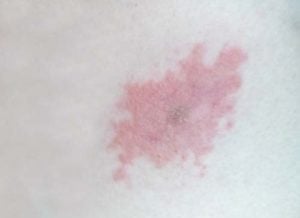
It is not rare that a small bump appears at the point of the puncture after vaccination in dogs, which could sometimes be an allergic reaction.
But don't regret having your dog vaccinated!
This change is generally not dangerous and is only an aesthetic problem that will disappear over time.
INTERESTING READ: 40% Pet Owners Believe Dog Vaccines are Unsafe; Experts Say Not True
6. Folliculitis 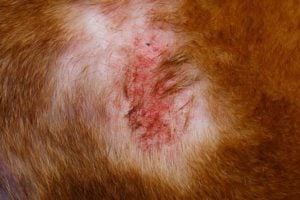
Folliculitis is an infection that includes red bumps in hair follicles around the outer side of the dog's vulva.
While at first harmless, without adequate treatment, they will develop pustules and scabs over time.
This needs to be addressed, and the primary treatment will include simply better hygiene and sometimes antibiotics for up to two months.
7. Sebaceous Cysts 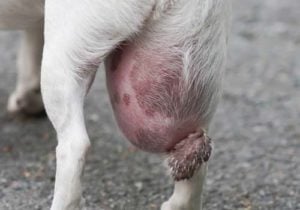
Such sebaceous cysts in dogs occur when the sebaceous gland becomes blocked, similar to how humans get acne and cysts.
But don't pop them like you might do on a pimple!
The condition is entirely benign, and the vet will solve the problem by cleaning and encapsulating the bump.
If left untreated, it may disappear anyway, but it may still recur.
8. Papules 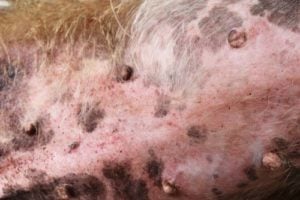
The papules (pustules) in dogs are a type of relief bumps smaller than 0.4 inches (1 cm) in diameter that occur on the dog's skin, including private areas.
The causes could be numerous, such as allergies, exposure to toxic substances, or follicular infections.
In most cases, they disappear without any treatment.
9. Abscess 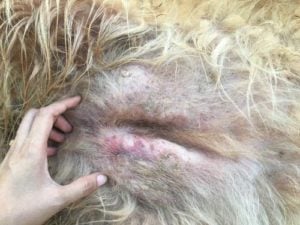
This bag near your dog's private area will be filled with pus and occurs mostly around poorly healed and infected injuries or bites.
It can be located anywhere on the dog's body, including the vulva area.
Fortunately, the treatment is uncomplicated. Your vet will drain the abscess and will prescribe ointments and creams to speed up the healing.
10. Urticaria (Hives) 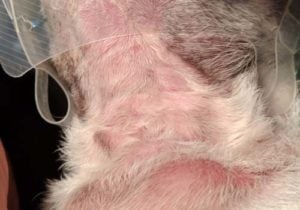
Urticaria in dogs is a rash of red, round, itching bumps on the skin.
The most common underlying cause is a reaction of the animal's body to some allergen.
In most cases, hives in dogs will disappear on their own. But in more severe cases, the vet will prescribe an antihistamine to reduce irritation.
11. Lipomas 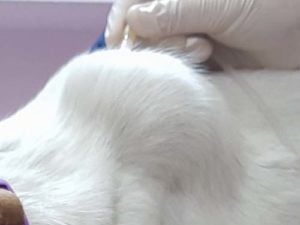
Lipomas are benign tumors – fatty, soft bumps located under your pet's skin, most commonly seen in middle-aged dogs of any breed and gender.
They are often considered a part of aging and don't require removal. Overweight dogs are more prone to this condition.
12. Mast Cell Tumors 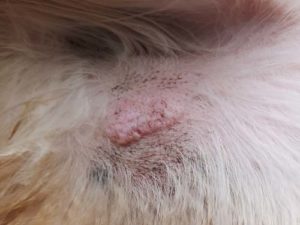
The mast cells are regularly spread throughout the dog's body, but they can sometimes become malignant without any apparent reason.
The most common canine skin cancer causes bumps anywhere on the body, including the vulvae region.
Breeds prone to this are older Bulldogs, Beagles, Golden Retrievers, Boston Terriers, Labradors, Schnauzers, and Boxers.
13. Melanoma 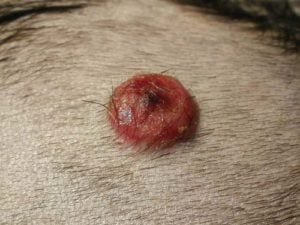
Once melanocytes (pigment-carrying cells) grow uncontrollably, canine melanoma tumors will occur.
When the cause of this condition is not sunlight, the bumps are usually benign and treatable.
Unfortunately, the prognosis of aggressive melanomas is not promising.
Canine melanoma is a very aggressive neoplasm, accounting for 3–8% of all neoplastic diseases in dogs and a median overall survival of 8–12 months after diagnosis. (Source)
14. Transmissible Venereal Tumors 
Even though it is quite a rare contagious disease in dogs, Transmissible Venereal Tumors are highly dangerous.
It is the only sexually transmitted cancer that passes on from one dog to another directly during copulation.
Once singular or multiple bumps occur on the dog's vulva, it is necessary to take your pet to the vet and start with an adequate treatment right away.
Clinical history, signalment and cytological features are often obvious for establishing a diagnosis though biopsy and histological examination may be needed in atypical cases. Most cases are curable with three intravenous injections of vincristine sulphate at weekly intervals. (Source)
It is highly recommended to spay the dog after healing to avoid future infection.
Other Potential Explanations
It is also possible that your dog has vaginal hyperplasia, which only affects female dogs that are not spayed.
The area appears as red or pink swollen tissue and protrudes from the canine’s vulva. It only occurs when your dog is in heat.
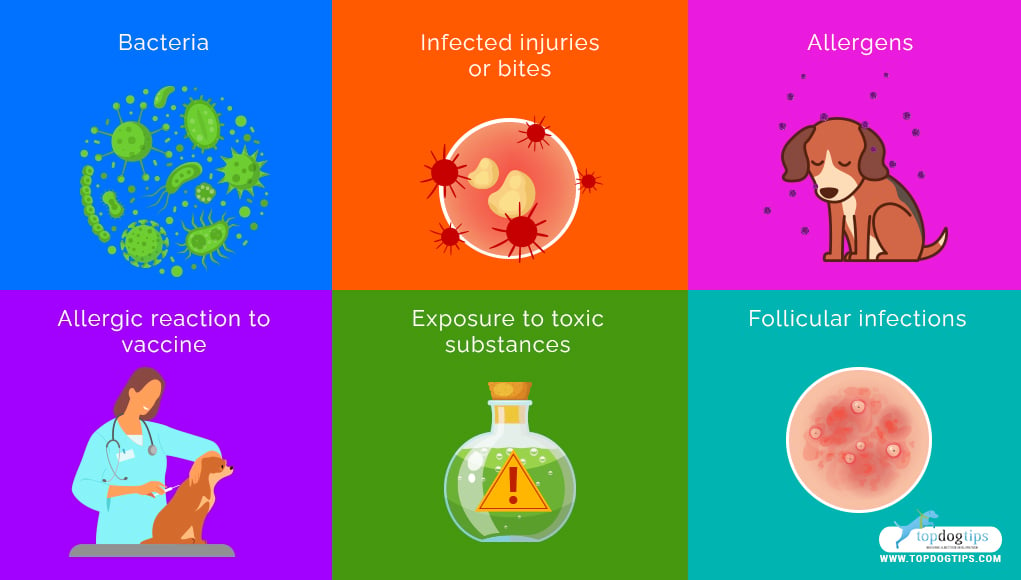
Diagnosis and Treatment for Bump on a Dog's Private Area
If the mass or the red bump around your dog's privates doesn't go away after a couple of days and you see it worsening, that's the ultimate time you should see your vet.
Dr. Connell said vets also take into consideration your pup's age when diagnosing the cause of the strange bump.
They will also ask how long the mass has been there, possible changes in size, shape, and color, if any, and your dog's overall health condition before performing the tests.
“Usually, the first step for a diagnosis is to perform a fine-needle aspirate,” explains Dr. Connell. Here, your vet will collect cells from the bump and examine them under a microscope.
Biopsy is another option your vet can do, where a tiny mass sample will be surgically removed from your dog's bump under anesthesia.
“If neither of these procedures provides a conclusive diagnosis, your veterinarian may recommend a CT scan,” Dr. Connell says.
After a diagnosis has been decided, that's when your vet will discuss treatment options.
“Accurate information is empowering, whereas the volume of information and potential diagnoses found online can be overwhelming,” Dr. Connell added.
FAQs for When My Dog Has a Bump on Her Private Area
Can Dogs Get Pimples on Their Private Parts?
Yes, although acne does not usually affect adult dogs, it can happen.
In addition to pimples, your dog may get whiteheads or blackheads on the chest, lips, chin, or genital area.
Why Is My Female Dog’s Private Area Swollen?
If your dog’s private area is swollen, she may be in heat.
This typically happens one or two times a year and lasts about three weeks.
If your dog is fixed, the swelling is likely related to one of the other issues mentioned above and may require a vet visit.
Why Does My Male Dog Have a Bump on His Privates?
It is not normal for male dogs to have growths, bumps, or lumps on their penis. They may be from injuries or infections.
They may also be related to tumors, cysts, and inflammation.
What Does a Sebaceous Cyst Look Like on a Dog?
You can see an image of a sebaceous cyst on a dog above.
They are usually small and well-defined, raised, rounded areas of the skin.
Dogs typically only get one, but your dog may have several close together.
Can I Pop a Pimple on My Dog?
No, don’t pop a pimple on your dog. This can increase the risk of your dog’s hair follicles rupturing.
The inflammation may get worse.
Dog Has a Bump on Her Private Area? You Should Do This…
Once you spot a bump on your dog's private area, you should take your pet to the vet for examination.
Your vet's diagnosis and prognosis are important to determine what your next step should be.
Bumps on a dog's vagina may be harmless, but in some cases, they may possibly be harmful enough to require serious treatment.
Want to read more related articles to dog bumps and masses? Click the links below!
Related Articles:
- There Are Bumps Under Your Dog's Fur: Here's 5 Things It Could Be
- New Cancer Treatment for Dogs: A Hope for Increasing Lifespan
- Tumors Of The Vagina In Dogs
Share this article?
